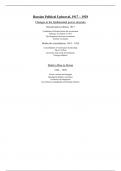Russian Political Upheaval, 1917 – 1929
Changes to the fundamental power structure
Dissent and revolution, 1917
Conditions of Russia before the revolutions
February revolution of 1917
Developments between revolutions
October revolution
Bolshevik consolidation, 1918 – 1924
Consolidation of Communist dictatorship
The Civil War
Economic and social developments
Foreign relations
Stalin’s Rise to Power
1924 – 1929
Power vacuum and struggle
Ideological debates and issues
Economic developments
Government, propaganda and foreign relations
,Dissent and revolution, 1917
Conditions of Russia before the revolution
The tsar and political authority
Russia before the revolutions of 1917 was an autocracy (rule by one person)
As this time, the autocrat was Tsar Nicholas II, whose personal failing as a leader had
seriously weakened his political authority.
Reasons for weakened authority:
- His personality
o Believed in his divine right to rule
o Was stubborn and saw advice as criticism
o Undermined his ministers to stop anyone challenging his authority
- Alexandra and Rasputin
o A self-styled ‘holy man’ who helped the prince Aleksei w his haemophilia
o Alexandra (German) encouraged Nicholas to listen to Rasputin’s advice
o He had rumours of his sexual promiscuity – esp. w Alexandra
- The state Duma
o Forced to allow a State Duma, elected representative assembly, in 1906
o Debated politics and legislation, but the Tsar refused to share any real power
o Nicholas remained responsible for Russia’s problems
- Nicholas and Russia’s problems
o Believed there was a religious bond between the Tsar and the people
o Russia should put its faith in God and tradition
o Nicholas did not actively try to solve problems, thought God would
Opposition to Tsarism
There were three main groups of political opposition:
Liberals Social Revolutionaries Social Democrats
Loose collection of groups Founded 1901 Founded 1898
Wanted reform & a Represented peasant interest Represented proletariat, the
constitutional monarchy – e.g., land reform industrial working class
Included Constitutional Internal divisions, some 1903, split in Mensheviks
Democrats (Kadets), believed in assassination – and Bolsheviks due to how
Octobrists and Progressives moderate wing control 1905 to apply Marxism to Russia
Figes’ Theory of 4 Pillars
(what is needed to support Tsarist rule)
,The Russian war effort
In July 1914, Russia mobilised to help Serbia.
When Germany joined the war, Russia experienced serious defeats. By early 1917, Russian
defeats in WW1 was a major cause of discontent.
During the war, there was 1 surgeon to every 100,000 men. By the end of 1916, there had
been 1.7 million deaths and 5 million casualties.
(*) Zemstva = institution of local govt set up under Alexander II
Economic and social state
The cost of the war caused major economic problems and had social impact.
There were food shortages in towns and cities
- Millions of men conscripted caused labour shortages, reducing food supplies
- Peasants hoarded their grain rather than selling it
- Food supplies prioritised for the army, meaning towns were undersupplied
- Railway system turned over to transporting military supplies – towns low priority
There was a rising cost of living (due to runaway inflation)
- To pay for the war, the govt raised taxes and took out loans
- Shortages of food / manufactured products raised prices higher, leading to inflation
- Unemployment increased as non-military factories closed due to a lack of supplies
The food shortages and unsanitary conditions led to increase in the death rate of workers in
the towns and cities.
, This, along with the increased cost of living and unemployment, led to unrest & strikes
January 1917 30,000 workers on strike in Moscow
145,000 workers on strike in Petrograd
The Russians war effort was massively unorganized, using outdated and unsuitable tactics.
The Brusilov Offensive was a Russian assault in summer 1916. The method was unplanned
but this worked well for the Russian army. In the end, the offensive fell in late September
1916 because they began to set out a plan (Taylor).
“losses in Galicia … cleared the way to revolution in the following year” – AJP Taylor
Discontent in Russia
Most of the discontent were expressed towards those in positions of power. It manifested in
the form of strikes, unrest in the countryside and desertions from the armed forces
The Tsars refusal to cooperate with the Progressive bloc caused discontent – Progressives
discussed his possible abdication.
Workers and soldiers were becoming increasingly open to radical political ideals – most
radical opponents of the Tsar were, however, in exile or prison





